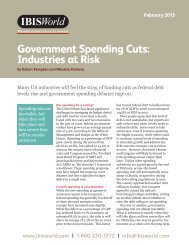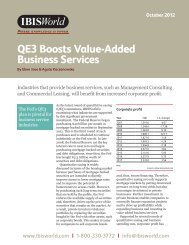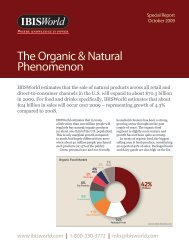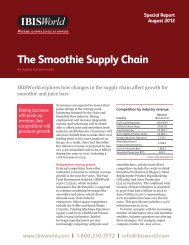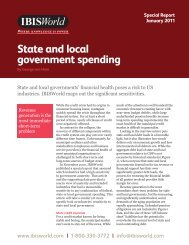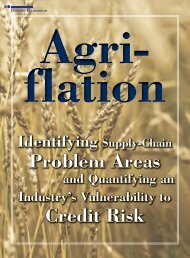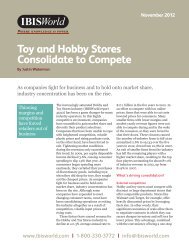Wedding Industry - IBISWorld
Wedding Industry - IBISWorld
Wedding Industry - IBISWorld
You also want an ePaper? Increase the reach of your titles
YUMPU automatically turns print PDFs into web optimized ePapers that Google loves.
Clearly, all of these categories have a sizable<br />
sensitivity to wedding demand drivers such as<br />
number of engagements, per capita disposable<br />
income, unemployment levels and job security,<br />
and consumer confidence. At the same time, each<br />
of the seven revenue sources has unique risks and<br />
key success factors. The wedding industry cannot<br />
be grouped into a single frame when determining<br />
how much a lender may need to financially support<br />
a business. Rather, each sector must be reviewed<br />
individually and its operators evaluated in terms of<br />
other sources of revenue and the competition from<br />
other industries providing similar services.<br />
Figure 3<br />
64,000,000<br />
63,000,000<br />
62,000,000<br />
61,000,000<br />
60,000,000<br />
59,000,000<br />
58,000,000<br />
Total Population 20-34 and Median Age<br />
at First Marriage<br />
28<br />
27<br />
26<br />
25<br />
24<br />
23<br />
The Reception<br />
The reception is the biggest expense of a wedding,<br />
generating an estimated 38% of total industry revenue<br />
($17.94 billion in 2010). The reception sector<br />
can be broadly classified as the “accommodation<br />
and food services” division. Major costs associated<br />
with the reception include venue rental, food and beverages,<br />
food service and bartender, wedding cake, and hotel for<br />
the bride and groom.<br />
Customers spend a considerable amount of time choosing<br />
the reception location and making it fit their demands.<br />
For this reason, the reception operates with unique risks<br />
compared to other categories. Potential customers can be<br />
deterred from choosing a specific location or company<br />
over minor issues, and that equates to a loss of business<br />
opportunity.<br />
Like all industries, firms in this area must continually<br />
meet and satisfy their key success factors so that they remain<br />
competitive and viable. Table 1 shows six related <strong>IBISWorld</strong><br />
industries that have direct influence on the wedding market<br />
and fall into the accommodation and food services sector.<br />
From a wedding perspective, these figures show opportunities<br />
for new businesses. Operators within the<br />
industries low on the list can seek to capitalize on<br />
an improving wedding industry by directing more<br />
of their marketing toward this potential clientele.<br />
Developing good word-of-mouth recommendations,<br />
fostering excellent customer relations, having a welltrained<br />
staff, and implementing appropriate pricing<br />
policies will help moderate the business risks associated<br />
with this highly competitive sector.<br />
<strong>Wedding</strong> Attire<br />
The wedding attire category incorporates the retail,<br />
rental, and personal services sectors. However, most<br />
of the category is related to the retail sector, where<br />
product and service substitutes abound. Customers<br />
are able to move easily from business to business<br />
in search of outfits and accessories.<br />
57,000,000<br />
56,000,000<br />
1980 1982 1984 1986 1988 1990 1992 1994 1996 1998 2000 2002 2004 2006 2008<br />
Figure 4<br />
Total Population 20-34 (L)<br />
<strong>IBISWorld</strong> has identified eight industries with a direct<br />
effect on the wedding attire category (Table 2). Major selling<br />
items include the<br />
bridal dress, groom<br />
and groomsmen attire,<br />
bride and groom accessories,<br />
bridesmaid<br />
outfits and accessories,<br />
and hair and makeup.<br />
This sector is estimated<br />
to account for 12.4% of<br />
total spending, coming<br />
in at $5.85 billion.<br />
Medium Age at First Marriage (R)<br />
Substitution is a huge competitive disadvantage for wedding<br />
firms specializing in the attire market. This factor is<br />
particularly true for formal wear and costume rental, given<br />
The Seven Revenue-Generating Areas<br />
<strong>Wedding</strong> Size: $47.2 billion—2010<br />
<strong>Wedding</strong> Planners<br />
2.0%<br />
Flowers<br />
4.5% Photography<br />
8.8%<br />
Other<br />
24.1%<br />
<strong>Wedding</strong> Rings<br />
10.2%<br />
22<br />
21<br />
Source: <strong>IBISWorld</strong> estimates<br />
The wedding industry<br />
cannot be grouped<br />
into a single frame<br />
when determining how<br />
much a lender may<br />
need to financially<br />
support a business.<br />
<strong>Wedding</strong> Attire<br />
12.4%<br />
Reception<br />
38.0%<br />
Source: <strong>IBISWorld</strong> estimates<br />
The RMA Journal December 2010–January 2011 25



